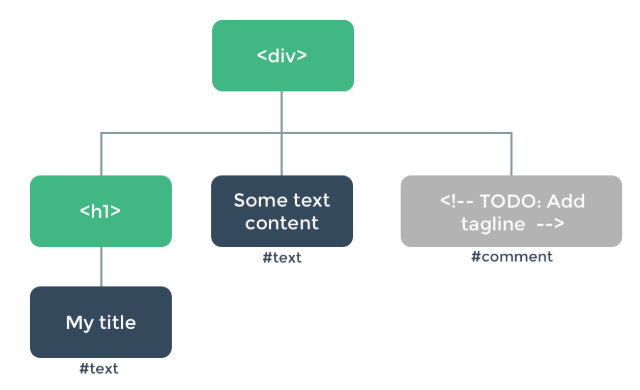# 渲染函数和JSX
Vue推荐绝大多数情况下使用template来创建html,但某些情况使用渲染函数render更好,它比模板更接近编译器。
# 基础示例
通过level给出不同的h标签
<div id="app">
<!--
参数传递时,默认为字符串,如果非变量,且不是字符串,
可以加上v-bind,保留其自身类型
-->
<a-heading level="1">Hello world!</a-heading>
<a-heading level="2">Hello world!</a-heading>
<a-heading level="3">Hello world!</a-heading>
<a-heading level="4">Hello world!</a-heading>
<a-heading :level="5">Hello world!</a-heading>
<a-heading :level="6">Hello world!</a-heading>
</div>
Vue.component('a-heading', {
props: ['level'],
template: `
<h1 v-if="level === '1'">
<slot></slot>
</h1>
<h2 v-else-if="level === '2'">
<slot></slot>
</h2>
<h3 v-else-if="level === '3'">
<slot></slot>
</h3>
<h4 v-else-if="level === '4'">
<slot></slot>
</h4>
<h5 v-else-if="level === 5">
<slot></slot>
</h5>
<h6 v-else="level === 6">
<slot></slot>
</h6>
`
})
使用 render函数,重构
var k = Vue.component('a-heading', {
render: function(createElement) {
return createElement(
'h' + this.level, // 标签名字
this.$slots.default // 子节点数组
// a-heading元素的内容,会被存储在组件实例中的 $slots.default中
)
},
props: ['level']
})
# 节点、树以及虚拟DOM
浏览器在读取HTML文档时,会创建一个DOM树,来追踪所有内容。
<div>
<h1>My title</h1>
Some text content
<!-- TODO: Add tagline -->
</div>
DOM树

vue template与render函数
<!-- template -->
<h1>{{ blogTitle }}</h1>
<!-- 对应的render -->
<script>
render: function(createElement) {
return createElement('h1', this.blogTitle)
}
</script>
# 虚拟DOM
Vue 通过建立一个虚拟 DOM 来追踪自己要如何改变真实 DOM。
return createElement('h1', this.blogTitle)
createElement会返回什么? 不是实际的DOM元素,而是 createNodeDescription.
- VNode/虚拟节点(virtual node): render参数createElment(或其他)函数执行,会返回createNodeDescription,包含渲染的节点及其子节点的描述信息,这样的节点称为虚拟节点(VNode).
- 虚拟DOM:由Vue组件树建立起来的整个VNode树的称呼
# createElement参数
createElement接收3个参数
- 第一个参数:必选,{String | Object | Function} 一个 HTML 标签名、组件选项对象,或者resolve 了上述任何一种的一个 async 函数。
'div'
- 第二个参数:可选,Object, 一个与模板中属性对应的数据对象。
- 第三个参数:可选,{String | Array},子级虚拟节点 (VNodes),由
createElement()构建而成,也可以使用字符串来生成“文本虚拟节点”
[
'先写一些文字',
createElement('h1', '一则头条'),
createElement(MyComponent, {
props: {
someProp: 'foobar'
}
})
]
# 深入数据对象
v-bidn:class和v-bind:style在模板语法中被特别对待,VNode数据对象中,也有对应的顶层字段。数据对象也允许绑定普通的 HTML 特性(属性),也允许绑定如 innerHTML 这样的 DOM 属性 (这会覆盖 v-html 指令)。
{
// 与 `v-bind:class` 的 API 相同,
// 接受一个字符串、对象或字符串和对象组成的数组
'class': {
foo: true,
bar: false
},
// 与 `v-bind:style` 的 API 相同,
// 接受一个字符串、对象,或对象组成的数组
style: {
color: 'red',
fontSize: '14px'
},
// 普通的 HTML 特性
attrs: {
id: 'foo'
},
// 组件 prop
props: {
myProp: 'bar'
},
// DOM 属性
domProps: {
innerHTML: 'baz'
},
// 事件监听器在 `on` 属性内,
// 但不再支持如 `v-on:keyup.enter` 这样的修饰器。
// 需要在处理函数中手动检查 keyCode。
on: {
click: this.clickHandler
},
// 仅用于组件,用于监听原生事件,而不是组件内部使用
// `vm.$emit` 触发的事件。
nativeOn: {
click: this.nativeClickHandler
},
// 自定义指令。注意,你无法对 `binding` 中的 `oldValue`
// 赋值,因为 Vue 已经自动为你进行了同步。
directives: [
{
name: 'my-custom-directive',
value: '2',
expression: '1 + 1',
arg: 'foo',
modifiers: {
bar: true
}
}
],
// 作用域插槽的格式为
// { name: props => VNode | Array<VNode> }
scopedSlots: {
default: props => createElement('span', props.text)
},
// 如果组件是其它组件的子组件,需为插槽指定名称
slot: 'name-of-slot',
// 其它特殊顶层属性
key: 'myKey',
ref: 'myRef',
// 如果你在渲染函数中给多个元素都应用了相同的 ref 名,
// 那么 `$refs.myRef` 会变成一个数组。
refInFor: true
}
# 完整示例
<h1>
<a name="hello-world" href="#hello-world">
Hello world!
</a>
</h1>
显示上面的组件